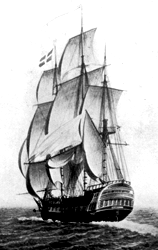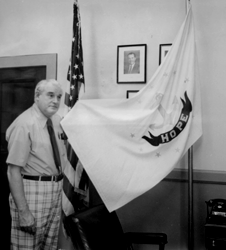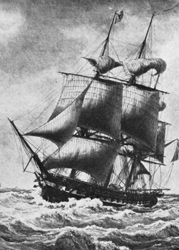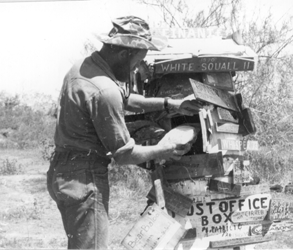|

Paquebot (Ship Mail)
What is it and it's history
In the old days, the seven oceans were not so crowded by ships as they are today. If
sailing ships spotted another sail on the horizon, they usually came close, unless the
crew was afraid of pirates. Especially whaling ships were happy to see company on their
oftentimes two year long whaling voyages. It was the only opportunity to get some news. A
long boat was lowered, captains visited each other, often dined together, and sometime
even the crew was allowed to visit each other's ships and have some fun.
Of course, if one of the ships was full of oil and was heading back to it's home port,
that was the only occasion to send messages back to loved ones. If the ships had the same
home port, it was definitively no problem to deliver the mail. News about an arriving ship
spread quickly and everyone came to check for news. But what about the ship returning to a
different port, or even a different country? How was the mail delivered then? Who paid the
postage and in what currency......?
Well, all of that led to an international agreement about Ship Mail known as Paquebot,
French being the world's official postal language. Simply put, if you are on the open sea,
which belongs to nobody, the deck you are standing on is the territory of the country
under which flag the ship sails. That means, that if you write a letter on the ship's deck
and on the high sea, you should be able to use the stamp of the country under which the
ship sails - pirate flags excepted of course :). That also means, that if a ship enters a
harbor, the officer should be able to hand over the mail to the local post office at that
harbor in whatever country, and the mail should be delivered without any additional
charge.

What were the chances of that happening in reality? I would say pretty good. Personally
I was using Paquebot since 1966. Being born in Czechoslovakia and sailing the seas under
the Czechoslovakian flag, I had to face many problems. One of the biggest was the lack of
western currency. Iron curtain politics with all the political hoopla and trade barriers,
forced Czechoslovakian government to set strong restriction on money exchange (as it was
in many other countries at that time, even in England). Basically $5.00 pocket money was
expected to cover my needs abroad. It's understandable that under these circumstances, I
could not spent my very limited resources on mail.
Well, I solved my mailing problem with Paquebot. Since then I was sailing continuously
with my own post office on my 24 foot sailing boat.

I bought a large quantity of Czechoslovakian stamps (I was sailing under Cechoslovakian
flag), and met my financial needs as well as made all my friends and fans very happy, and
stamps collectors very jealous.
The basics of Paquebot is ratified by international convention. It is left to the
individual countries to set the procedures for each country, and of course to set the
stamp value. Myself, being from landlocked country, located in the center of Europe
without sea shore, I was skating on some thin ice. Czechoslovakia had a few ships based in
Germany and Poland, but no rules for ship's mail. I was one of the few to use it. Would
the government spend time discussing regulations because of some crazy solo sailor?!
As an example, I wrote a letter on my little Nike in the middle of the Pacific, and
then handed my mail to GPO (General Post Office) at Papeete (Tahiti), I used domestic
Czechoslovakian stamps. I was mailing from Czechoslovakian territory (from the deck of my
boat) to Czechoslovakia. It was not my fault that the mail had to travel half way round
the world. Nobody objected to that. There were no other rules and nobody bothered to make
new ones. I never lost a letter.
I would never forget one of my postcard, which I mailed to my friend at Martinique from
Marquises. Before the postcard reached the destination, my friend moved out and a month
later the postcard was mailed back to its originating mailing place. That time I was
sailing single-handedly round the world on my 24 foot long Nike.

When the postcard came back, I had already left the islands, but I also left my next
address - GPO Tahiti, Poste Restante. So, the postcard followed me to Tahiti.
Unfortunately, I was faster. The postcard then followed me to Cook Islands, to Tonga, to
Fuji, to New Caledonia, to Australia but could not catch me. There was no empty space on
the postcard left to stamp it or to put a new address. Well, having used Czechoslovakian
stamps, the postcard ended up in Czechoslovakia. Some postmaster, pride of his profession,
located my address (there was no return address on the postcard), and in the end my wife
received the postcard. I was somewhere on Madagascar by that time. That's what I call a
service! The computers did not exist at that time - not at the post offices of
Czechoslovakia and all those small islands.
I had a problem only once - at Tonga. First, the postmaster took my mail. He knew what
to do with my Paquebot. Every postmaster always knew what the Paquebot was about, even on
small forgotten islands in the middle of some big ocean. But the next day he returned the
mail back to me with an apology. Tonga become an independent country and a new government
had not ratified the old international convention yet! So, the following day I was
affixing a beautiful Tongan stamps next to my old Czechoslovakian ones. My friends were
delighted.
The only problem I always had was in the USA. Finishing my first solo transatlantic
race - The OSTAR 1972, I handled my
Paqueboat to GPO at Newport. They did not know what to do with it, and I ended up at the
post master office. A couple hours later I left the building and the post master accepted
my mail. He found the proper paragraph in his black book of instruction. At the end, a
local newspaper photographer even took picture of both of us in front of USA and Rhode
Island flags in his office.

At Puerto Rico I spent a couple of hours dealing in matters of Paquebot again. Being
from socialist Czechoslovakia and well watched, the correct department happily took care
of my quite big mail bag. Three 'helpful' sturdy men carried my Paquebot themselves to the
many miles distant post office (all my mail was received by addressee). I knew that the
mail must be safe. I could see silhouettes of hand guns under my delivery men's shirts.
At the Panama Zone I faced a new problem. GPO wanted an AV-2 form, which by US rules
should accompany my mail. But nobody had the forms and nobody even knew what the AV-2 form
should look like. I was lucky, at Colon there were a lot of shipping agents. In the end I
got the US form at the British office. The form had a lot of bureaucratic nonsense. No
other country requested so much useless information just to send the mail, so I simplified
the form and made my own. I was very careful to print "Form AV-2" at the top
corner of my form and everybody was happy.
I again visited Newport during my second solo transatlantic race The OSTAR 1976. Everybody celebrated the 200
years anniversary. There were many tall ships in the harbor, but probably nobody used
Paquebot.
This time the post office clerk could easily locate the proper paragraph in his book,
with my help. However, I came across a new problem. The American instruction says the ship
using Paquebot must be a commercial ship. I argued, that the international convention does
not distinguish between the commercial or other ships, and I presented the clerk with the
printed convention - I only had the French version. The clerk capitulated and accept my
mail. So I learned about another weak spot, and mastered my "mailing" skill
further.
When I visited Newport once again, during The OSTAR 1980, I had everything ready. I had
printed an AV-2 form, I had a nice big, round ship's rubber stamp. The stamp proudly
displayed my boat name, and stated that the mail was posted on the high sea on the deck of
my "Vessel" Nike. Nobody can argue about the word vessel - it is just as
appropriate for yachts as for commercial ships. I also had a nice rubber stamp with my
captain title (no problem what with my holding master diploma) and with my name. And of
course a Paquebot rubber stamp - you can seldom find it in the modern post office run by
computers. I also had a copy of the convention ready, and I knew where to find the
instruction. All mail handling went smoothly and with big smiles on both sides.
I used my Paquebot again during my solo round the world race - The BOC
Challenge1982/83. Everything went smoothly in all countries. After the race I settled
in the USA and I hoisted an American flag on my boat. Well, to the loss of all my friends,
fans and philatelists, the American vessels cannot use Paquebot in USA ports. Also,
instruction forbids the use of Paquebot by non-commercial boat. So, if I would like to use
my Paquebot by the old tradition way, I would probably have to fly a Liberian flag (not
for me, thank you).
For my special Paquebot mail during the second BOC Challenge1986/87
I had to request a special permit from Washington. I got it with no problem at all. The
Newport post office was very helpful. But it was almost ten years ago and I was wondering
what the situation is now, so I went to check on it.....

When I asked about Paquebot, the answer was: "..we do not handle it any more, it
was abandoned..". Well, I live by a nice maritime slogan: "Do not give up the
Ship!". I argued, that Paquebot is international law, and that as far as I know the
congress did not discuss anything in this matter. Maybe you do not have it in you
computer, but what about your old black instruction book? The paragraph on Ships Mail was
found in the second half of the book, on the right side of the page.... the same as 19
years ago.
The instruction on Paquebot is still there. You still need an AV-2 form, but yachties
do not try it. Paquebot is for commercial ships only. At least in the USA. Sorry, Paquebot
collectors.
There is one place in the world, where the old traditional way of ship mail is still
highly respected. Since1787 whaling ships often visited Galapagos Islands, to get
long-lasting turtles. They were the best kind of fresh naturally-canned food. Most
probably British whalers affixed an oil barrel on the shore of Santa Maria Island. They
cut an opening in the barrel and affixed a small door to close it. Since that time, the
whalers left their mail in the barrel for the first ships that sailed home. It still works
today. Even the bay was specially named "Barrel Post Office Bay". The first
chart mark about this "Post Office" goes back to 1793.

I used it the last time in 1974. The original barrel was still there attached to some
kind of a post. Still working. Many passing sailing boats decorated the "Barrel Post
Office" with a special tablet carrying the ship's name. Now there is a new barrel
next to the old one. There are no more whaling ships to come and pick up mail. The life on
Galapagos is hard. The archipelago is poor, but the local Postal Authority is taking a
grandiose care about left over mail.

I left over two hundred letters and postcards in the barrel. Well, my mail had
Czechoslovakian stamps affixed. I also left an AV-2 form (just in case). I could see many
other letters without stamps (no Money or Money Orders attached either) in the barrel.
All my mail was delivered. I am pretty sure that that was done not just because I left
a bottle of whiskey, a can of nuts, and some other goodies in my mail bag. (To tell the
truth, leaving the bottle behind, I was afraid that some passing drunken sailor may pick
it up. Hopefully the bottle made the day only of the servicing Postmaster and his crew).
Find out about the Special BOC Challenge 1986/87 Paquebot
Copyright
Creators of this site put a lot of effort and a lot of their time in gathering all
presented information. If you want to use any of published facts for your private or
commercial project, please contact us first. We will be willing to let you use our data
for a fee, which only will help us to make this web better. We discourage copying our
information directly from this web without our knowledge. It may be destructive to you
project, because many presented information are unique and many has small blunders which
would link unauthorized copier to our source. Thank you for respecting the Copyright.
Copyright Richard Konkolski
Back to Filatelie

|